
On an increasingly overbuilt planet where daily experience with the natural world is limited, at best, gardens can serve as places to reconnect with nature. The norm today is, sadly, tired, clichéd landscape installations for public or commercial sites, or over designed, trendy private outdoor spaces. In both cases, plants have been treated as second-class citizens—the last things considered.
Plants ignite a powerful relationship between people and a garden space when their beauty, variety, and ability to change are celebrated. They can appeal, at once, to the personal preferences of the gardener, enhance a site and its characteristics, and embrace the uniqueness of a specific region. A garden created with favorite plants in mind—first and foremost, rather than after site and hardscaping considerations have been set in stone—deepens our connection with the garden. Putting plants first in the design process restores the vitality of outdoor spaces and allows them to be truly celebrated gardens.
Elements of a plant-driven design
When it comes to planning and planting a garden, don’t just choose plants that you love and plunk them down in any old spot. Be sure to place these treasured favorites in spots where their best attributes will shine and where their conditional needs will be met. Every garden design should contain plants that embody the following characteristics.

1. Fragrance
A pungent odor is emitted when you brush up against the foliage of wild quinine (Parthenium integrifolium, Zones 4–8). Plants that not only pique your visual interest but also your sense of smell are important for cementing a visceral link with the landscape.
2. Texture
The soft, frondlike leaves of ‘Sutherland Gold’ elder (Sambucus racemosa ‘Sutherland Gold’, Zones 3–7) stand out for not only their color but also their pillowy texture, which is in direct contrast to the surrounding plants with broad leaves.
3. Seasonality
Conifers, like this Colorado blue spruce (Picea pungens, Zones 2–8), are crucial in providing year-round interest but really become key players in winter when nothing else is looking good.
4. Form
Grecian foxglove (Digitalis lanata, Zones 3–9) is eye-catching for its color and its strong architectural presence. Having plants that make an impression because of their shape adds another layer of interest to a design.
5. Color
The hues of your plants should take a hint from their surroundings. Here, the bright blooms of yellow coneflower (Echinacea paradoxa, Zones 5–8) stand out against the green backdrop but also complement the chartreuse leaves of the elder.
Consider site, purpose, and plants simultaneously
Designers typically lay out a space first, then select and place plants on the site to meet predetermined goals. Gardeners, on the other hand, usually acquire their favorite plants first, then search for suitable spots to place them. The ideal approach is to consider purpose, space, plant selection, and placement all at the same time.
The creation of our home garden in northern Colorado is an example of plant-driven design. Our property was an uninspired, flat half acre in a recently built subdivision—a blank slate of half-dead lawn, rather than the more typical suburban inheritance of ragtag, poorly placed landscape plants and endless mulch. The majority of land was in the back (for extra privacy), with nice views to the west, and the site was blessed with deep soil—something rare in our region. Otherwise, this was about as prosaic a beginning for a garden as one could imagine.
A little fragrance goes a long way 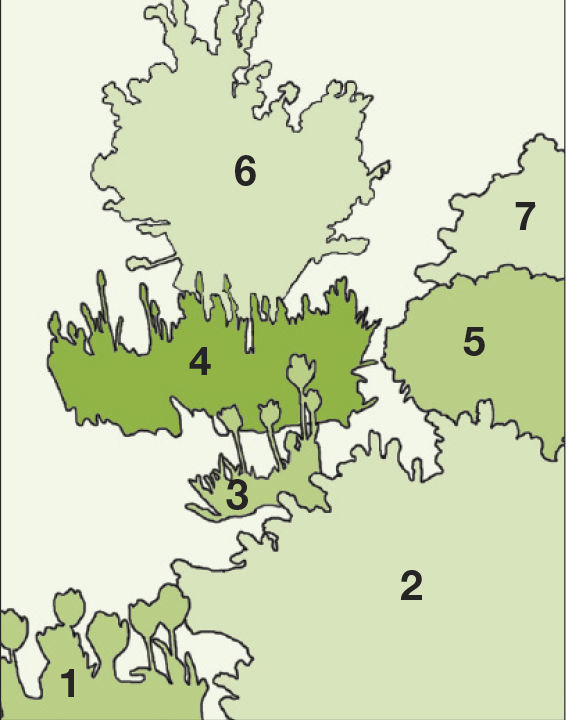 1. ‘Princes Irene’ tulip(Tulipa ‘Princes Irene’, Zones 4–8) 2. ‘Mesa Verde’ Colorado blue spruce (Picea pungens ‘Mesa Verde’, Zones 2–8) 3. Tulip (Tulipa cv., Zones 4–8) 4. Lady tulip (Tulipa clusiana, Zones 4–8) 5. Cushion spurge (Euphorbia polychroma, Zones 5–9) 6. ‘Crandall’ clove currant (Ribes odoratum ‘Crandall’, Zones 5–8) 7.‘Hillside’ Colorado blue spruce (Picea pungens ‘Hillside’, Zones 2–8) |
We started thinking immediately about which of our much-loved plants would thrive, given these challenges and opportunities. Naturally occurring conditions, like good deep soil, meant we could grow lots of different plants, especially trees and shrubs. We joyfully and greedily set about making a list of desired trees. The following spring, we planted close to 100 of them: for screening, for shade, for fruit, to frame views, and some just because we liked the plants so much and wanted to experiment with them in our climate.
The scenic surroundings of our property inspired our garden’s style and, in turn, our plant choices. We decided to create meadow, steppe, chaparral, and rock gardens to echo the land forms and plant communities beyond, linking the garden to the snippet of wild beauty that we could see right out our door. What favorite plants of ours would echo the spirit of the regional landscape? And which ones would also satisfy our goal of sustainable diversity by tolerating a low input of water and no soil amendments or fertilizers, and only requiring as much care as the two of us could provide given our time constraints and the size of the lot?
Conifers of all sizes—mainly pines (Pinusspp. and cvs., USDA Hardiness Zones 3–10) and spruces (Piceaspp. and cvs., Zones 2–8)—were good choices because they grow well in our climate and dominate much of the native mountain woods yet they offer a diversity of species and forms. Certain ornamental grasses were also ideal choices, echoing the short-grass prairie our subdivision had displaced and giving the eye a needed rest with the softness and serenity of a low, fine-textured planting (similar to a lawn but more interesting and less resource intensive). We satisfied our passion for bulbs by inter planting thousands of ephemeral bloomers and a smattering of rarer species. A plant-rich garden was developing that continually fascinated and involved us.
Capture and highlight the spirit of your plants
A plant-driven garden is created around a love for certain plants. Those plants have unique appeal and individual personalities that foster interaction and connection while meeting other design goals. Most important, their cultural needs must be addressed. But beyond that, you need to find ways to show off the attributes that draw you to them.
Strong colors and forms are important in every design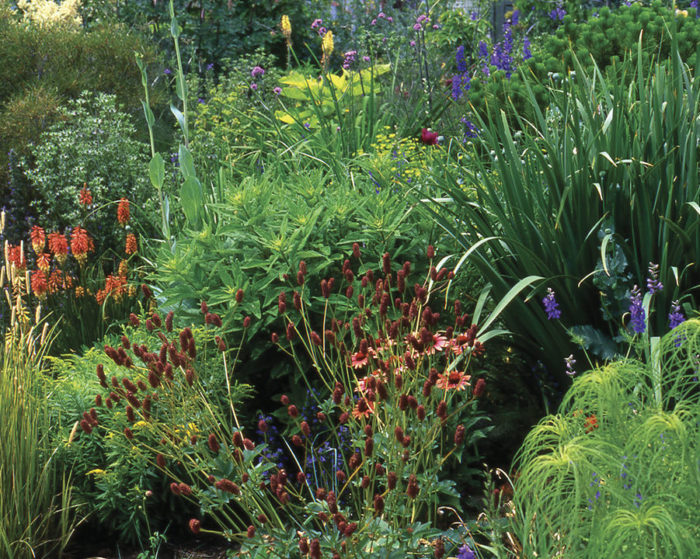 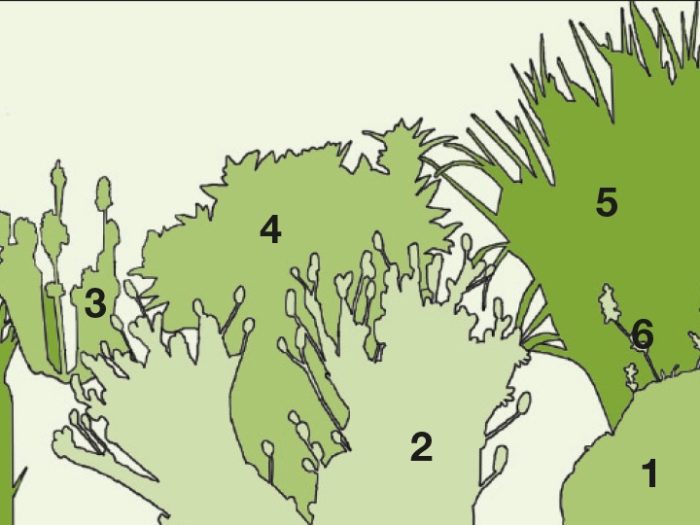 1.Willowleaf sunflower(Helianthus salicifolius, Zones 6–9) 2. Burgundy burnet (Sanguisorba menziesii, Zones 4–8) 3. Red-hot poker (Kniphofia cv., Zones 5–9) 4. ‘Little Joe’ Joe Pye weed (Eutrochium dubium ‘Little Joe’, Zones 3–9) 5. ‘Fontanelle’ spuria iris (Iris ‘Fontanelle’, Zones 6–9) 6. Annual larkspur (Consolida ambigua, annual) |
Specific plant qualities, such as seasonality, fragrance, texture, form, and color, should be celebrated. Colorado, like much of the country, has marked seasons. With that in mind, we chose plants that would thrive in our exuberant, moist spring; dry yet pleasantly warm summer; crisp, bright autumn; and long but crystalline winter. Jewel-toned bulb blooms, like crocuses (Crocus chrysanthuscvs., Zones 3–8), small species tulips, and others, give us high hopes in spring while the rest of the garden still sleepily holds back. Summer explodes with ornamental grasses and our favorite drought-resistant perennials, such as firecracker penstemon (Penstemon eatonii, Zones 4–9), ‘Walker’s Low’ catmint (Nepeta faassenii ‘Walker’s Low’, Zones 4–8), and golden dome alyssum (Alyssum markgrafii, Zones 4–8), which add a splash of vibrant color.
Fall is when many deciduous trees, such as serviceberry and Rocky Mountain Splendor™ birch, take their turn in the spotlight with outrageous autumnal hues. As winter descends, grasses go tawny and much of the garden retreats to monochrome as conifers become the stars, with their intriguing green, silver, and blue silhouettes often dusted in snow.
Fragrance encourages up-close encounters with certain plants, so these are essential in any design. They should occupy prime spots along pathways or by seating areas. A beloved fringe tree and common lilacs (Syringa vulgaris cvs., Zones 4–8) are given places of pride near our main routes. ‘Crandall’ clove currant is one of the earliest fragrant things to bloom for us, before the viburnums even think of opening. It is intensely fragrant, and I plant it in almost all gardens I design in this region. These scented beauties encourage a close connection to the garden because of their sensual appeal.
Color is most effective when taking its cue from the surrounding landscape. In Colorado, for example, lush green is secondary to sage green, silver, gray, and blue for much of the year, so we planted an array of silvery subshrubs, such as artemisia (Artemisiaspp. and cvs., Zones 3–9) and salvia (Salviaspp. and cvs., Zones 5–11). Brightly colored flowers show better than pastels in the fierce sun. Luminescent red-hot poker and blue larkspur hold up to the sun of high noon and glow when backlit in the morning and afternoon light.
Seasonality and texture ensure that the garden never sleeps
1. Atlas fescue (Festuca mairei, Zones 4–8) 2. Rocky Mountain Splendor™ birch (Betula ‘Rockimon’, Zones 4–7) 3. Ohio buckeye (Aesculus glabra, Zones 3–7) 4. Hop tree (Ptelea trifoliata, Zones 5–9) 5. Serviceberry (Amelanchier canadensis, Zones 3–7) 6. Fringe tree (Chionanthus virginicus, Zones 4–9) 7. ‘Carolina Moonlight’ false indigo (Baptisia ‘Carolina Moonlight’, Zones 4–9) 8. Aromatic aster (Aster oblongifolius, Zones 4–9) 9. Arizona corkbark fir (Abies lasiocarpa var. arizonica, Zones 5–6) |
To me, textural and sculptural plants are vital in any garden because of their long season of interest and ability to set a mood. At home, columnar trees and shrubs block our closest neighbor, stopping the eye along the narrowest part of the garden with their arresting sentinel-like forms. Spiky plants, such as bear grass (Xerophyllum tenax, Zones 5–8) and agave (Agavespp. and cvs., Zones 7–11), create strong year-round structure amid twiggy, more amorphous, drought-resistant shrubs and perennials. Grasses, like Atlas fescue, lend a sensual softness to the often lumpy, bumpy medium textures of so many herbaceous plantings (photo, above). They make our garden seem larger and more generous.
As a garden grows, it develops, over time, its own sense of rhythm and balance that puts people and plants together in a comfortable context. The gardener/designer’s hand and the will of the plants engage in their own dance of spontaneity and control. Pruning, editing, renewing, and replacing are as much the essence of plant-driven design as that first exciting creation on paper and in bare earth. Gardens where plants come first—no matter the style or the region—promise change, surprise, and delight. A relationship is born and a reconnection with the natural world is made.
Accentuate Plant Traits with Light
In a garden, light changes its quality and direction every minute of every day, yet it is often overlooked in design. Be sure to consider how a plant’s form and texture respond to light before deciding where it should be placed.
Fuzzy or opaque:

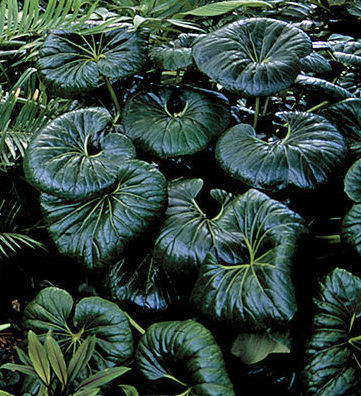
Plants with hairy or fluffy surfaces (like the ornamental grasses, pictured) trap light, highlighting their unique textures. Backlighting translucent leaves and petals creates a glow.
Reflective:
Some flowers and foliage have shiny qualities. These plants, when hit with light, gleam.
Architectural:
Plants with a bold outline are sculpted by strong light and shadow, and give the landscape striking silhouettes.

Lauren Springer Ogden and her husband, Scott, are garden designers in Fort Collins, Colorado, and are the authors of Plant-Driven Design.
Photos and designs, except where noted: Lauren Springer Ogden
Fine Gardening Recommended Products

The Crevice Garden: How to make the perfect home for plants from rocky places
Fine Gardening receives a commission for items purchased through links on this site, including Amazon Associates and other affiliate advertising programs.

Planting in a Post-Wild World: Designing Plant Communities for Resilient Landscapes
Fine Gardening receives a commission for items purchased through links on this site, including Amazon Associates and other affiliate advertising programs.

SHOWA Atlas 370B Nitrile Palm Coating Gloves, Black, Medium (Pack of 12 Pairs)
Fine Gardening receives a commission for items purchased through links on this site, including Amazon Associates and other affiliate advertising programs.

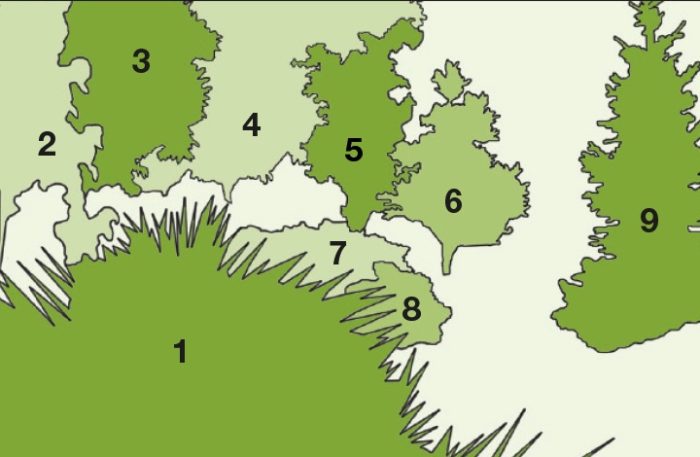

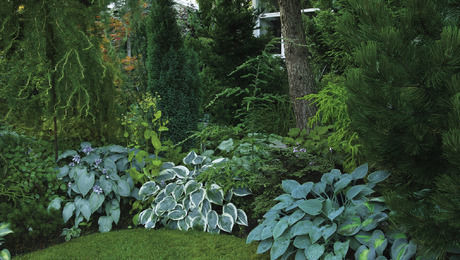
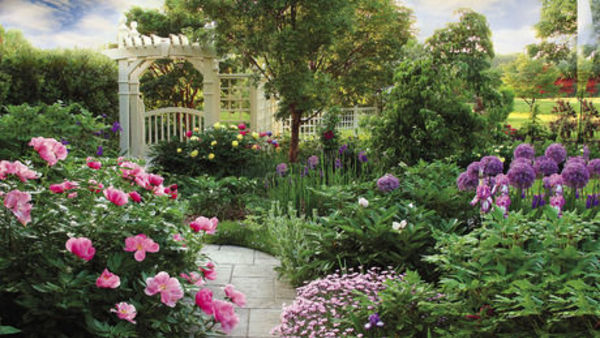














Comments
Log in or create an account to post a comment.
Sign up Log in